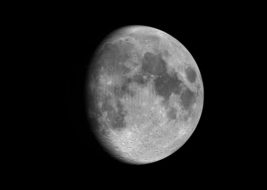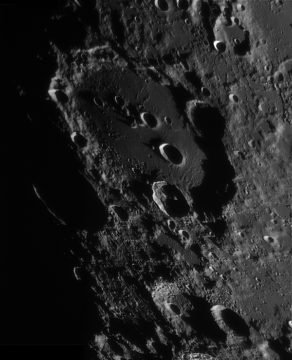Join fellow lunar enthusiasts this Saturday, October 20th, for International Observe the Moon Night!

Virtual Moon Atlas 6.0
Do you feel awestruck every time you look up and see our closest celestial neighbor? I sure do. Whether it’s the slimmest of crescents, ethereally suspended in the waning twilight, or a half Moon with an impossibly straight terminator, or the blazing orb of the full Moon seemingly bursting with light as it traverses the night sky, I cannot get enough of our satellite. I want to know all about its craters, ridges, and maria — I envy the astronauts who walked on the Moon’s surface, returned to Earth covered in Moon dust, and who bandied about terms such as “breccia,” “rille,” and “regolith.”
If you are as fascinated by the Moon as I am, why don’t you take advantage of Saturday’s International Observe the Moon Night? This event debuted in 2010, very much the thrust of the Lunar Reconnaissance Orbiter and Lunar Crater Observation and Sensing Satellite mission teams. The event is also sponsored by other NASA institutes dedicated to increasing our understanding of and appreciation for the Moon, such as the Lunar and Planetary Institute, the Planetary Science Institute, NASA's Solar System Exploration Research Virtual Institute, and several others. Their collective aim is to get people inspired by our closest cosmic neighbor, and to instill both a sense of awe in the Moon and a desire to learn more about its history and science.
International Observe the Moon Night is normally scheduled for a Saturday in September or October as close to a first-quarter Moon as possible. Why a first-quarter Moon? There are several very practical reasons for this.
To begin with, the Moon at first quarter is high enough already in the late afternoon or evening sky, and in the fall, it’s sufficiently dark for observing (which means people don’t have to stay up until the wee hours of the morning, and younger observers do not have to miss their bedtimes). Another — very good, I might add — reason to schedule this for a quarter Moon is that surface features are so much more exciting, especially during dusk-time observing when shadows are long. The waxing gibbous Moon (as it will be on Saturday) is perfect for observing craters, valleys, and ridges, especially near the terminator where you see these features in dramatic chiaroscuro.
What do you need to do to participate in International Observe the Moon Night? For starters, just step outside and look up! The wonderful thing about our Moon is that it is so accessible. Go into your backyard, or local park, and find the Moon: You can already see so much by simply casting your gaze skyward. With binoculars, you start to see startling details of the craters and ridges, and a telescope brings these features into sharp relief.

Sean Walker
What if you don’t have binoculars or a telescope but want to get a closer look? No problem: Science museums, planetariums, and local astronomy clubs all over the world organize events to bring people together on this night. Find one near you for Saturday.
One option, if you do have your own telescope, is to create your own event. Find a spot — even in town, the Moon is bright enough not to be impeded too much by light pollution — set up your telescope, and eager viewers will be lining up for their share of time at the eyepiece.
What if it’s cloudy, I hear you ask. No worries there, either. Several organizations are planning webcasts, such as Gianluca Masi’s Virtual Telescope Project live-streaming event featuring the historic skyline of Rome starting at 16:00 UT (12 p.m. EDT, 9 a.m. PDT) on Saturday, October 20th.
Don’t forget to check out Bob King’s recent post for a different perspective on the Moon — see Earth through the eyes of NASA astronauts Harrison Schmidt and Gene Cernan from the landing site of Apollo 17.
No matter how you choose to view the Moon, do take a peek on Saturday evening and stop for a moment to ponder the magnificence of our very own rocky satellite. Be moonstruck.
 0
0
Comments
You must be logged in to post a comment.